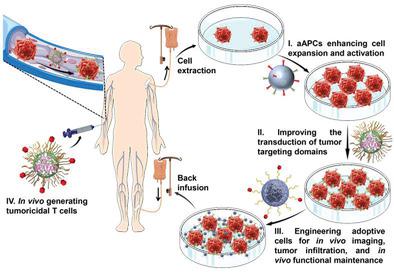当前位置:
X-MOL 学术
›
Small Methods
›
论文详情
Our official English website, www.x-mol.net, welcomes your
feedback! (Note: you will need to create a separate account there.)
Engineering Nano‐Therapeutics to Boost Adoptive Cell Therapy for Cancer Treatment
Small Methods ( IF 10.7 ) Pub Date : 2021-02-23 , DOI: 10.1002/smtd.202001191 Chunxiong Zheng 1 , Jiabin Zhang 1 , Hon Fai Chan 2 , Hanze Hu 3 , Shixian Lv 4 , Ning Na 5 , Yu Tao 1 , Mingqiang Li 1, 6
Small Methods ( IF 10.7 ) Pub Date : 2021-02-23 , DOI: 10.1002/smtd.202001191 Chunxiong Zheng 1 , Jiabin Zhang 1 , Hon Fai Chan 2 , Hanze Hu 3 , Shixian Lv 4 , Ning Na 5 , Yu Tao 1 , Mingqiang Li 1, 6
Affiliation

|
Although adoptive transfer of therapeutic cells to cancer patients is demonstrated with great success and fortunately approved for the treatment of leukemia and B‐cell lymphoma, potential issues, including the unclear mechanism, complicated procedures, unfavorable therapeutic efficacy for solid tumors, and side effects, still hinder its extensive applications. The explosion of nanotechnology recently has led to advanced development of novel strategies to address these challenges, facilitating the design of nano‐therapeutics to improve adoptive cell therapy (ACT) for cancer treatment. In this review, the emerging nano‐enabled approaches, that design multiscale artificial antigen‐presenting cells for cell proliferation and stimulation in vitro, promote the transducing efficiency of tumor‐targeting domains, engineer therapeutic cells for in vivo imaging, tumor infiltration, and in vivo functional sustainability, as well as generate tumoricidal T cells in vivo, are summarized. Meanwhile, the current challenges and future perspectives of the nanostrategy‐based ACT for cancer treatment are also discussed in the end.
中文翻译:

工程纳米疗法以促进癌症治疗的过继细胞疗法
尽管将治疗细胞过继转移到癌症患者身上取得了巨大成功并幸运地被批准用于治疗白血病和 B 细胞淋巴瘤,但潜在的问题包括机制不明确、程序复杂、对实体瘤的治疗效果不佳和副作用,仍然阻碍其广泛应用。最近纳米技术的爆炸式发展导致了应对这些挑战的新策略的先进发展,促进了纳米疗法的设计,以改善癌症治疗的过继细胞疗法 (ACT)。在这篇综述中,新兴的纳米技术,设计用于体外细胞增殖和刺激的多尺度人工抗原呈递细胞,提高了肿瘤靶向域的转导效率,总结了用于体内成像、肿瘤浸润和体内功能可持续性以及在体内产生杀肿瘤 T 细胞的工程治疗细胞。同时,最后还讨论了基于纳米策略的 ACT 用于癌症治疗的当前挑战和未来前景。
更新日期:2021-02-23
中文翻译:

工程纳米疗法以促进癌症治疗的过继细胞疗法
尽管将治疗细胞过继转移到癌症患者身上取得了巨大成功并幸运地被批准用于治疗白血病和 B 细胞淋巴瘤,但潜在的问题包括机制不明确、程序复杂、对实体瘤的治疗效果不佳和副作用,仍然阻碍其广泛应用。最近纳米技术的爆炸式发展导致了应对这些挑战的新策略的先进发展,促进了纳米疗法的设计,以改善癌症治疗的过继细胞疗法 (ACT)。在这篇综述中,新兴的纳米技术,设计用于体外细胞增殖和刺激的多尺度人工抗原呈递细胞,提高了肿瘤靶向域的转导效率,总结了用于体内成像、肿瘤浸润和体内功能可持续性以及在体内产生杀肿瘤 T 细胞的工程治疗细胞。同时,最后还讨论了基于纳米策略的 ACT 用于癌症治疗的当前挑战和未来前景。


















































 京公网安备 11010802027423号
京公网安备 11010802027423号